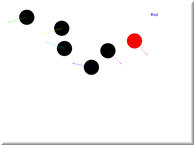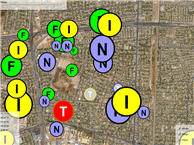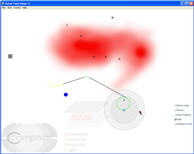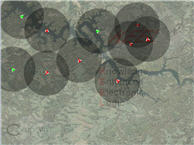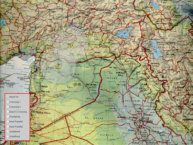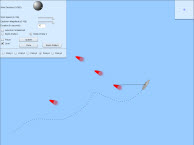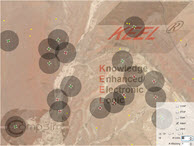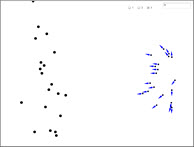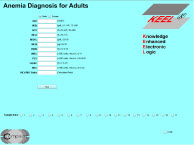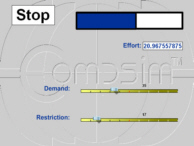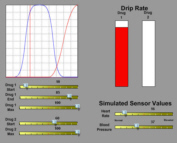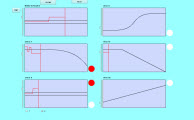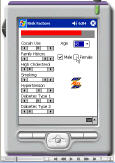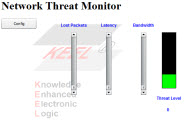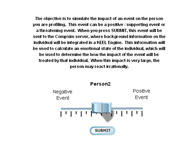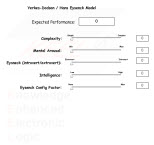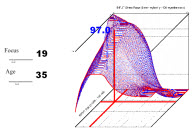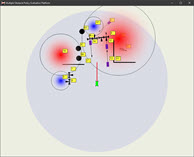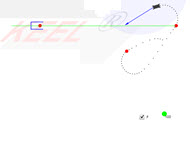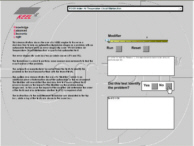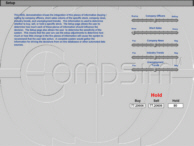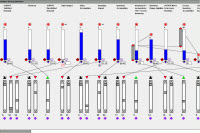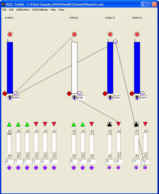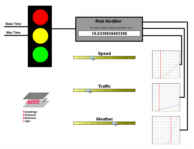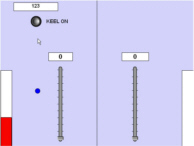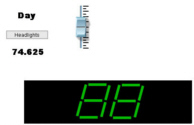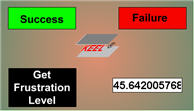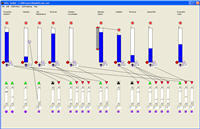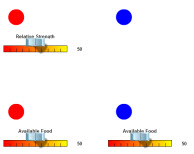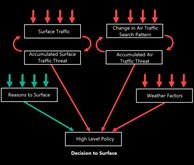| Military Applications Using KEEL Technology |
1. Unmanned Aerial Vehicle (UAV) Demo - Incorporating Frustration and Tunable Reasoning Model
|
|
Demonstrates the intelligent
behavior of two Unmanned Aerial Vehicles by executing the same behavior on the
web that can be embedded in a microprocessor controlling a real UAV. A single
design can be deployed in a device and on the Internet. (Note: This demo makes
use of a 1024 x 768 battlefield.) From a cognitive standpoint this demo uses a
slightly enhanced version of the KEEL engine demonstrated in the Command and
Control Demo below (collision avoidance added). Updated
to include frustration as a goal seeking technique.
|
2. KEEL Dynamic Graphical Language Source Code for UAV Demo Above
|
|
This is a rendering of the
KEEL Dynamic Graphical Language. It is an approximate rendering of what is
provided within the KEEL Toolkit (Development Environment). It provides a view
of how the design can be tested and evaluated. It does not, however, provide
editing capabilities.
|
|
|
|
UAV "swarms" need to self-organize
to select a leader. The swarm will need to reorganize automatically as the
environment changes. This demonstration utilizes KEEL "Engines" in each UAV to
self-evaluate itself and automatically determine whether it should be the
leader or not. This decision is based on a set of inter-related
criteria.
|
|
|
|
This demonstration uses KEEL
Technology to interpret information and apply auditable policies defined in the
KEEL dynamic graphical language to determine if and when a target is suitable
for attack by an Unmanned Combat Aerial Vehicle (UCAV).
|
5. UAV Surveillance Demonstration
|
|
This demonstration shows a UAV
tracking a vehicle. KEEL Engines handle the collision avoidance and are used to
choose surveillance locations that are optimized for safety, timing, and
nearness to mobile repeater sites. Contact Compsim for an
explanation.
|
6. Swarm Management Demonstration
|
|
Demonstrates 20 Unmanned Aerial
Vehicles (UAVs) navigating within an area, flying to user defined target points
and demonstrating swarm management behavior. (Note: This demo makes use of a
1024 x 768 battlefield.) This demo is also available as an Adobe AIR
application from Compsim.
|
7. Collision Avoidance Demonstration
|
|
Several test cases are provided to
show different collision avoidance cases. Two UAV's are positioned in different
positions and driven to collide. Radio buttons select the case. (Note: This
demo makes use of a 1024 x 768 battlefield.) Another view
|
8. Shipboard Policy Evaluation
|
|
This demonstration processes several
evasion policies for ship that might encounter dirty bombs. KEEL models are
processed for contaminant distribution and for ship policies. (This demonstration was prepared at the request of SPAWAR personnel
for presentation at the SISO conference 3/24/2009)
|
9. Swarm Formations Demonstration
|
|
Demonstrating Adaptive Operational Policies for swarms with controlled formations with policies that can be influenced in real time.
|
10. Ballistic Missile Defense
|
|
Demonstrating algorithms for a Ballistic Missile Defense System with slower defensive UAVs. Work in progress on Outfielder Models.
|
11. Ship Collision Avoidance
|
|
Work in progress: Modeling Ship Collision Avoidance Data leading to an Operational Policy Controlling the Behavior of Ships. This was part of a larger solution to assist in the development of the collision avoidance policy.
|
12. Ship Collision Warning System
|
|
With human error identified as the cause for two US Navy ships colliding in 2017, this demonstration highlights the use of KEEL Technology as a means to avoid these problems in the future. |
13. Sense And Avoid / Sense And Engage
|
|
Video showing the KEEL SAPES (Sense and Avoid Policy Evaluation System) used to streamline the development and test of Sense and Avoid / Sense and Engage operational policies.
|
| Medical
Applications |
|
|
|
|
|
Demonstrates the use of KEEL to
interpret diagnostic information from a hemotological analyzer. Explains
diagnosis and why other diagnoses might be incorrect. This is a demonstration
only.
|
2. Portable Artificial Lung Demo (Covid-19 Ventilator Control)
|
|
Pulse oximetry provides estimates
of arterial oxyhemoglobin saturation (SaO2) by utilizing selected wavelengths
of light to non-invasively determine the saturation of oxyhemoglobin (SpO2).
This is a simple demonstration of a control system for a portable artificial
lung created with the KEEL Toolkit. It dynamically adjusts to demand and could
be driven by non-invasive Pulse oximetry sensors or by more invasive techniques
such as integration with pacemakers.
|
3. Automatic Drug Dispensing Demo
|
|
Demonstration of the automatic
dispensing of drugs based on blood pressure and heart rate sensors.
Demonstrates the feasibility of allowing a physician to configure the drip rate
of multiple drugs for real-time feedback from sensors according to a set of
curves. This would allow continuous adjustment of the drip rate based on the
patient's activity and changing blood pressure.
|
4. Patient Monitoring / Sensor Monitoring / Event Triggered Monitoring / Time-based Monitoring Demo
|
|
Demonstration allows the user to
define expected reactions to medical events such as the case when individual
patients metabolize drugs at different rates. Care givers can model expected
reactions that are triggered by events and alarm only when unexpected events
happen.
|
5. Chest Pain Risk Factors Demo
|
|
This demonstration shows a KEEL
application running on an emulation of a Windows Mobile PDA. This demonstration
shows the collection of several risk factors that might be observed when a
patient arrives at a hospital complaining of chest pain. This accumulation of
risk factors is one of the tools used in evaluating the likelihood that there
is a heart problem that needs immediate care. A KEEL engine is accumulating the
individual factors to determine an overall risk factor. |
6. Triage Symptom Evaluation
|
|
In March of 2022, DARPA released the "In The Moment" (ITM) solicitation that suggested a 4.5 year multi-phase project to develop a tool to support the triage activity in a mass-casualty event. While Compsim did not pursue this research topic, we did create a working cognitive model in less than 2 hours over a weekend. A screen-capture of the cognitive development (research through engine creation) is available at: https://www.compsim.com/publicmovies/DARPAITMSolution/DARPAITMSolution.html The following weekend, we created 2 versions of a webpage that can be used on a cell phone to enter symptoms and get a suggested triage decision. Click on the title or thumbnail to get an explaination of the project and a link to the working webpage. |
| Homeland Security Applications using KEEL
Technology |
1. Network Threat Policy / Monitoring Demo
|
|
This demonstration shows how a
policy implemented in KEEL can interpret network statistics and determine a
threat level. Configuration parameters can support adaptive
sensitivity.
|
2. Human Event Profiling Demo
|
|
This demonstration shows a KEEL
Engine running on a server in an ASP file. It also demonstrates how historic
data can be merged with real-time event data to model a human response.
Expectancy Violation Theory |
3. Group Behaviorial Monitoring Demo
|
|
This demonstration shows how KEEL
Technology can be used to model the behavior of terrorist groups relative to
their interest in specific targets. Target relevance is evaluated.
Configuration parameters allow the importance of various factors to be
adjusted. |
4. Yerkes-Dodson / Eysenck Model
|
|
This demonstration shows how KEEL
Technology can be used to model the behavior based on the Yerkes-Dodson "law" as
modified with the work of Hans Eysneck.
|
5. Focused Stress by Age and Population
|
|
This demonstration models the
susceptibility of stress on target populations by age. It might be used to
model the behavior of individual or groups responding to the financial crisis,
an individual's response to a mugging, or a terrorist attack at a sporting
event. |
| Automotive Applications using KEEL Technology
|
1. Multiple Obstacle Avoidance Policy Evaluation System (MOAPES)
|
|
This is a video explaining the KEEL MOAPES desktop application that is used to develop and test policies controlling the operation of unmanned ground vehicles (like self-driving cars) that have to avoid obstacles and choose the best path to proceed. |
2. Human versus Autonomous Driving
|
|
This demonstration allows a human controlling a joystick to drive a car and compares that to autonomous driving. It exposes basic turn types that an autonomous vehicle will have to handle: turn to heading, turn to a vector, and turn to avoid an obstacle, all the time managing acceleration and deceleration. |
3. Automotive Diagnostic Tree
|
|
This demonstration shows KEEL
Technology implemented in dynamic test manuals that adapt to the tests
performed by a technician as well as external data to determine how the
decision tree should be traversed. |
4. Vehicle Tracking Control
|
|
Where we started - 2003 work on self-driving cars |
| Business and Financial Applications using KEEL Technology
|
|
|
|
Demonstrates a system that monitors
information and determines whether to buy, sell, or hold stock. Completely
tunable so the user can determine the importance of information in making the
final decision. Sensitivity of the system can also be tuned. |
2. Creating and Executing Organizational Policies
|
|
Suggests how KEEL can be used to
define and execute organizational policies and establish organizational
management (command and control) as a core competency of an
organization. |
3. Cost Effective Decision Making
|
|
This demonstration shows how a
simple decision can be modeled. In this case we are focusing on the selection
of the most cost effective option selection. It integrates, not only "cost",
but includes judgmental information like "effectiveness" and
"risk". |
| Multi-Purpose Demonstrations using KEEL
Technology |
1. KEEL Dynamic Graphic Language
|
|
Limited introduction to the KEEL Dynamic
Graphical Language.
|
|
|
|
Demonstrates a very simple data
fusion formula described using the KEEL "dynamic graphical language" and
executed function pointing to a 3-D graph surface. |
3. A Non-Linear KEEL Formula
|
|
Demonstrates a slightly more complex
non-linear formula described using the KEEL "dynamic graphical language" displayed on a 3-D graph surface. |
|
|
|
Demonstrates one of the canned
"dynamic" curves provided as a sample with the KEEL Toolkit. |
5. Intelligent Traffic Light
|
|
A common problem associated with
complex systems is the fusing (or combining) of non-linear signals in the
pursuit of some objective. This simple demonstration shows the integration of
three signals without resorting to complex coding techniques. An "intelligent
traffic intersection controller" is used to demonstrate the concept. The KEEL
code for the design is also demonstrated.
|
|
|
|
Performance
demonstration. |
|
|
|
Demonstrates the use of a KEEL
Engine to control the acceleration and deceleration rate of a motor in an
efficient way. No sharp movements. |
|
|
|
Complete development documentation
from Compsim walks a new user of KEEL technology through the development
process of this simple application. This information can be requested from
Compsim. |
|
|
|
Shows "reasoning" with a KEEL
Engine. This demonstration allows human reasoning for a specific topic (The
decision for a pre-emptive attack) to be explored in a manner that can be
understood beyond what can be accomplished with the human written or verbal
language. |
10. In Search of Frustration
|
|
Demonstrates the use of a KEEL
Engine in a simulation of frustration that might be used in electronic games
where there is a need to depict realistic frustration by animated figures in
the game. "Serious Games" are often used to simulate realistic situations where
frustration may come into play. This demonstration allows the user to stimulate
events and observe the frustration level increasing and
decreasing.
Compsim has prepared a white paper
titled "Should Computers Get Frustrated?" that
discusses the frustration model in more detail and addresses its use in control
applications. Contact Compsim directly for a copy. |
11. Intelligent Programmable Logic Controller (PLC)
|
|
This demonstration provides
supplemental information for ISA 2005 Presentation showing the ability to
utilize KEEL Technology to extend the capabilities of conventional PLCs to
incorporate human-like reasoning. This demonstration was provided at the 2005
ISA show in Chicago.
ISA
Paper: A Model for Human-like Reasoning in Programmable
Controllers
Application Note: KEEL
Technology in GE-PACSystems™ |
12. Heuristic Reasoning in Batch Processing Systems
|
|
This demonstration provides
supplemental information for the ISA 2005 Presentation showing the ability to
utilize KEEL Technology to automate judgmental decisions commonly performed by
humans in batch processing systems. This demonstration was provided at the 2005
ISA show in Chicago. |
|
|
|
This demonstrates a hypothesis for
controlling the interpretation of "reasons" embedded in a policy for
controlling the behavior of autonomous systems. |
|
|
|
A little game to highlight the challenge for humans when competing against KEEL-based machines. |
15. Complete Development Cycle
|
|
Overview of a complete development cycle with videos and demonstrations from Concept, to Development, to Simulation, to Refinement and Expansion, to full Simulation with a Configurable Operational Policy. |


